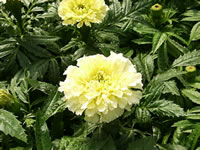How to Grow and Care for Marigold Plants
Tagetes patula, Tagetes erecta
           
Marigolds are one of the easiest of all plants to grow and care for, making them a
perfect plant for teaching young children about growing and gardening.
These spunky little plants are only hardy in zones 9-11 so they are normally grown as annual bedding plants.
Marigolds start blooming by mid spring and continue producing
their brightly colored single, semi-double or double flowers until the first frost in the fall.
They are easily cultivated in pots or planters and make great cut flowers.
|
 |
Marigolds were first discovered in Central and South America during the seventeenth century.
They were brought back to Europe where botanists eagerly began creating new hybrids.
The majority of the hybrids are crosses between the French Marigold, Tagetes patula, and the African Marigold, Tagetes erecta.
French Marigolds are small, fast growing, bushy plants that grow 12" tall and wide. French Marigolds will provide a non-stop show of dense, 1½"-2" Carnation-like double flowers in shades of yellow, orange or reddish-brown from early summer until late fall if the spent flowers are removed promptly.
The African Marigold is sometimes called an American or Aztec Marigold. They are branching, upright plants that can grow 18" to 36" tall. African Marigolds produce large (up to 5"), solitary , single or double, Daisy-like flowers in shades of orange or yellow.
|
|
Today, there are hundreds of hybrids that have resulted from African and French Marigold crosses and more are being created all the time. These cultivars may be dwarf border plants or tall growing for background plantings. The 2"-3½" flowers may be single or double. They may be solid red or solid yellow in color, or combinations of red and yellow.
Growing Requirements for Marigold Plants
Marigolds should only be grown in full sun.
They are not fussy when it comes to the soil they are grown in, as long as it is well-drained. They will
actually produce more flowers but less foliage if they are grown in soil that isn't too rich.
Plant Marigolds 12"-15" apart in the garden after all danger of frost has passed in the spring.
Water regularly until new plants become well established, after which Marigold plants become fairly drought tolerant
except during periods of high temperatures when they will need regular watering again.
Remove spent flowers regularly to prolong the blooming season.
Take precautions to protect your Marigold plants from slugs and snails!
How to Grow Marigolds from Seeds
Marigolds are very easily grown from seeds. These long black seeds are large enough that even young children can hold and plant them individually.
Marigold seeds can be planted in the garden after all danger of frost has passed, but for the best results and earliest flowers, the seeds can be sown indoors 6-8 weeks before the last expected frost.
The seeds of African Marigolds should be sown indoors 10-12 weeks early.
Barely cover the seeds with moist, sifted compost, then maintain a temperature within the growing medium of 70°-75° until germination, which takes as little as 5-7 days.
Thin the seedlings to 3" apart, or transplant them into pots when they are about 2" tall. Keep the soil evenly moist and shade them from full sun until they are 6" tall.
Pinch out the tips of new growth to promote bushy growth. |
|
|
|
|
|
Search The Garden Helper:



